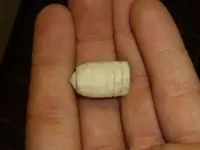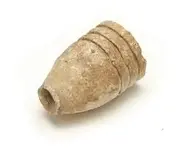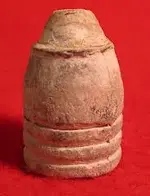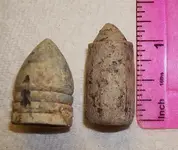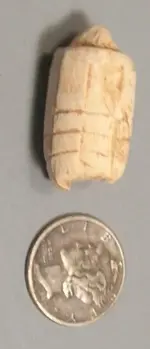It is a "hard-rammed" Minie-ball. Those can look similar to a pulled one. But notice that its nose got compressed down by the strong force needed to ram it down a very dirty bore. A bulletworm can cut some circular grooves around a bullet's nose, but it doesn't diminish the size of the nose. (The photos below show other examples of hard-rammed ones -- note the compressed-down nose on them.)
NewsMan, just in case you don't already know:
Repeatedly firing bullets using black gunpowder will quickly cause a buildup of gunpowder ash to coat the inside of the gunbarrel. That is called "powder-fouling." After a few dozen shots, the gun's bore gets narrowed down enough by the powder-ash buildup that ramming a bullet down the gunbarrel becomes difficult. The solution of course is to clean the caked-on ash out of the bore, but in a daylong fight with nonstop firing, you can't take the time to clean the bore. There are documented battlefield reports of civil war soldiers having to use a rock to pound the ramrod down the bore for loading the bullet. Your "hard-rammed" Minie-ball is evidence of that.
About its ID:
Both the yankees and Confederates manufactured 3-groove Minie-balls. Unfortunately, nothing on the outside of yours tells us whether it is a US or CS one. Sometimes they can be identified by the base-cavity's shape. Is it a simple cone, or "plug-base," or cup, or teat-in-cone cavity? We need to see a couple of well-fucused photos showing the Minie-balls base cavity.
There is one other clue which sometimes can help ID a 3-groove Minie-ball as a US or CS-made one: the clue is the battle-date. In comparison to the yankees, the Confederates made only a few 3-groove .58-caliber Minies with a "simple cone" cavity prior to 1864. So if one of that kind is found at a pre-1864 battlesite, the odds favor it being a yankee-made 3-groove Minie. The Battle of Cove Mountain was fought on May 10, 1864 -- so in your case, the battle-date doesn't help ID your Minie-ball as US or CS-made.
